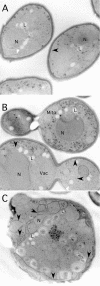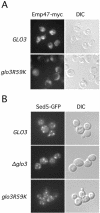The ArfGAP Glo3 is required for the generation of COPI vesicles
- PMID: 15254269
- PMCID: PMC515341
- DOI: 10.1091/mbc.e04-04-0316
The ArfGAP Glo3 is required for the generation of COPI vesicles
Abstract
The small GTPase Arf and coatomer (COPI) are required for the generation of retrograde transport vesicles. Arf activity is regulated by guanine exchange factors (ArfGEF) and GTPase-activating proteins (ArfGAPs). The ArfGAPs Gcs1 and Glo3 provide essential overlapping function for retrograde vesicular transport from the Golgi to the endoplasmic reticulum. We have identified Glo3 as a component of COPI vesicles. Furthermore, we find that a mutant version of the Glo3 protein exerts a negative effect on retrograde transport, even in the presence of the ArfGAP Gcs1. Finally, we present evidence supporting a role for ArfGAP protein in the generation of COPI retrograde transport vesicles.
Figures









Similar articles
-
Dissection of GTPase-activating proteins reveals functional asymmetry in the COPI coat of budding yeast.J Cell Sci. 2019 Aug 29;132(16):jcs232124. doi: 10.1242/jcs.232124. J Cell Sci. 2019. PMID: 31331965 Free PMC article.
-
The Glo3 GAP crystal structure supports the molecular niche model for ArfGAPs in COPI coats.Adv Biol Regul. 2021 Jan;79:100781. doi: 10.1016/j.jbior.2020.100781. Epub 2021 Jan 5. Adv Biol Regul. 2021. PMID: 33436318 Free PMC article.
-
The yeast Arf GTPase-activating protein Age1 is regulated by phospholipase D for post-Golgi vesicular transport.J Biol Chem. 2011 Feb 18;286(7):5187-96. doi: 10.1074/jbc.M110.185108. Epub 2010 Dec 6. J Biol Chem. 2011. PMID: 21135091 Free PMC article.
-
The structure of COPI vesicles and regulation of vesicle turnover.FEBS Lett. 2023 Mar;597(6):819-835. doi: 10.1002/1873-3468.14560. Epub 2022 Dec 30. FEBS Lett. 2023. PMID: 36513395 Review.
-
The role of ADP-ribosylation factor and SAR1 in vesicular trafficking in plants.Biochim Biophys Acta. 2004 Jul 1;1664(1):9-30. doi: 10.1016/j.bbamem.2004.04.005. Biochim Biophys Acta. 2004. PMID: 15238254 Review.
Cited by
-
An interaction between β'-COP and the ArfGAP, Glo3, maintains post-Golgi cargo recycling.J Cell Biol. 2023 Apr 3;222(4):e202008061. doi: 10.1083/jcb.202008061. Epub 2023 Feb 22. J Cell Biol. 2023. PMID: 36811888 Free PMC article.
-
The yeast p24 complex is required for the formation of COPI retrograde transport vesicles from the Golgi apparatus.J Cell Biol. 2008 Feb 25;180(4):713-20. doi: 10.1083/jcb.200710025. Epub 2008 Feb 18. J Cell Biol. 2008. PMID: 18283113 Free PMC article.
-
The Arf-GAP Age2 localizes to the late-Golgi via a conserved amphipathic helix.bioRxiv [Preprint]. 2023 Jul 24:2023.07.23.550229. doi: 10.1101/2023.07.23.550229. bioRxiv. 2023. Update in: Mol Biol Cell. 2023 Nov 1;34(12):ar119. doi: 10.1091/mbc.E23-07-0283. PMID: 37546741 Free PMC article. Updated. Preprint.
-
Dysregulated Arl1, a regulator of post-Golgi vesicle tethering, can inhibit endosomal transport and cell proliferation in yeast.Mol Biol Cell. 2011 Jul 1;22(13):2337-47. doi: 10.1091/mbc.E10-09-0765. Epub 2011 May 11. Mol Biol Cell. 2011. PMID: 21562219 Free PMC article.
-
Phosphatidylinositol transfer proteins and functional specification of lipid signaling pools.Adv Enzyme Regul. 2007;47:27-40. doi: 10.1016/j.advenzreg.2006.12.007. Epub 2007 Mar 1. Adv Enzyme Regul. 2007. PMID: 17335879 Free PMC article. No abstract available.
References
-
- Archambault, J., M.A. Drebot, J.C. Stone, and J.D. Friesen. (1992). Isolation and phenotypic analysis of conditional-lethal, linker-insertion mutations in the gene encoding the largest subunit of RNA polymerase II in Saccharomyces cerevisiae. Mol. Gen. Genet. 232, 408-414. - PubMed
-
- Cukierman, E., Huber, I., Rotman, M., and Cassel, D. (1995). The ARF1 GTPase-activating protein: zinc finger motif and Golgi complex localization. Science 270, 1999-2002. - PubMed
-
- Dogic, D., de Chassey, B., Pick, E., Cassel, D., Lefkir, Y., Hennecke, S., Cosson, P., and Letourneur, F. (1999). The ADP-ribosylation factor GTPase-activating protein Glo3p is involved in ER retrieval. Eur J. Cell Biol. 78, 305-310. - PubMed
-
- Elion, E.A. (1999). Detection of protein-protein interactions by coprecipitation. Curr. Protoc. Mol. Biol. 20.5.1.-20.5.9. - PubMed
Publication types
MeSH terms
Substances
LinkOut - more resources
Full Text Sources
Other Literature Sources
Molecular Biology Databases

